 Dear Friends,
Dear Friends,
I could really use your help!
You know how passionate I am about making schools better places for children. That’s why I have submitted a proposal to speak at the 2011 South-by-Southwest Conference. This conference could afford me with a great platform for educating the creative community about the current political threats to public education, and more importantly offer a constructive, creative and uplifting message illustrating alternative approaches that build upon each child’s remarkable capacity for intensity.
That is why I submitted the proposal, The Best Educational Ideas in the World. (Find the session description below and on the voting site.)
In order for me to be invited to speak at South-by-Southwest, (SXSW), I need for you and your colleagues, friends, relatives and students to spend a few minutes voting for my session. I apologize for how clumsy the web site is. That’s why I’ve included the following step-by-step instructions below:
- Go to: http://bit.ly/cxq78J
- Follow the instructions for creating an account
- An email will be sent to you containing a link to click that will return you to the voting site
- Click the link in the email
- Login using the email address and password you just created
- Click on the Explore the Interactive Proposals » link (http://bit.ly/bk31Hl)
- Type Stager into the Organizer field
- Click the SEARCH PANELS button
- My session, The Best Educational Ideas in the World, should appear
- Click the icon of the THUMBS UP to vote for my session.
- If you wish, click on the title of the session, scroll to the bottom of the page and leave a message of support. Every bit helps!
I am really grateful to each and every one of you who takes the time to follow the steps outlined above and votes for my session. Reaching multiple and varied audiences is the most effective way I can influence public opinion and help kids.
Unfortunately, this IS a popularity contest. That’s why I need your assistance.
All the very best,
Gary
The Best Educational Ideas in the World
Contemporary discussions of school reform focus on the creation of obedience schools for poor children or utopian governance schemes, such as charter schools. Neither approach does much to amplify the natural curiosity, expertise, creativity, passion, competence or capacity for intensity found in each child. A leading educator serves as your tour guide for a global exploration of powerful ideas and exemplary practices. Stops on the tour include personal fabrication; Reggio Emilia; El Sistema; Generation YES; One Laptop Per Child; a juvenile prison; 826 Valencia and more.
The artificial boundaries between art and science are blurred as children engage in authentic activities with real materials, create sophisticated artifacts of personal and aesthetic value and become connected to ideas larger than themselves. Collegiality, purpose, apprenticeship, complexity, serendipity and “sharaeability” are a few of the common values. Each approach either requires digital technology or may be dramatically enhanced by it. Lessons learned en-route our tour create productive contexts for learning in which students construct the knowledge required for a rewarding life.
Alternative models of school reform in which we treat other people’s students as our own will emerge. The common principles identified in some of the world’s most creative educational practices serve as lessons for parents, teachers and policy-makers eager to help children realize their full potential.
Questions answered during the presentation:
1. How can we create learning environments that build upon children’s capacity for intensity?
2. Are there humane creative models of school reform based on principles of social justice where students do extraordinary things?
3. How are disparate ideas like El Sistema, Reggio Emilia, personal fabrication, alternative prison education and One Laptop Per Child similar and offer new models for education reform?
4. Is learning natural and are children competent? Why do so many adults think that the answer is, “no?”
5. How can early childhood approaches be applied at the secondary level and the arts inform approaches to science?
Veteran educator Gary Stager, Ph.D. is the author of Twenty Things to Do with a Computer – Forward 50, co-author of Invent To Learn — Making, Tinkering, and Engineering in the Classroom, publisher at Constructing Modern Knowledge Press, and the founder of the Constructing Modern Knowledge summer institute. He led professional development in the world’s first 1:1 laptop schools thirty years ago and designed one of the oldest online graduate school programs. Gary is also the curator of The Seymour Papert archives at DailyPapert.com. Learn more about Gary here.

Done and done.
Also – done and done –
You got it Gary. Done.
Done
Thanks to everyone who showed their support!